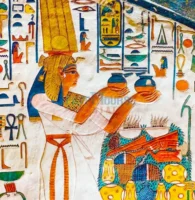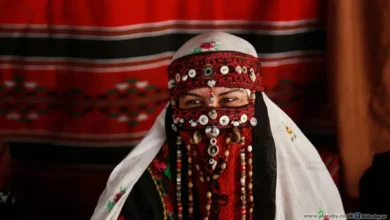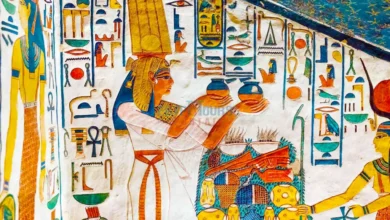ourney down the Nile to the lavish runways of the pharaohs. Discover the evolution of ancient Egyptian fashion, from simple white linen to intricate gold gowns, and its incredible legacy in today’s fashion world.
Ancient Egyptian Clothing
Picture the golden sands of the Nile, the imposing silhouette of a pharaoh, and the towering stone temples. Now, imagine the people who inhabited this world.
Their clothing was not just fabric. It was a language of power, spirituality, and unchanging status. Every thread, every color, and every bead had a purpose, telling a story of divinity, power, and social standing.
From the simple linen dresses of the common people to the intricate court gowns, ancient Egyptian fashion did not just cover the body; it covered the soul.
See also 🎨 The Symbolism of Colors in Traditional Egyptian Garments
🎨 The Symbolism of Colors in Traditional Egyptian Garments
In this journey through time, we will explore:
✅ The evolution of materials and styles.
✅ The status symbols that defined the hierarchy.
✅ The influence of other cultures on Egyptian fashion.
✅ The incredible legacy of ancient Egyptian fashion in today’s world.
Prepare to unveil the secrets sewn into the robes of the Egyptian kings and queens.
🏺 Part 1: The Dawn of Civilization (c. 3100-2686 BC) – Functionality and Linen
In the dawn of history, clothing was simple, practical, and, above all, functional.
What Was Worn?
- Materials: Linen (linen) and linen (flax). They were the perfect fabrics for Egypt’s hot and arid climate.
- Colors: Natural, earthy tones. The white of raw linen was the most common, symbolizing purity and the light of the sun.
- Style: Simple, shapeless garments. They were basically rectangles of fabric, draped shapelessly over the body. Functionality was king.
The Standard Dress: The Tunic or “Kalasiris”
- What was it? The main garment, for both men and women. It was a straight dress that was tied over the shoulder and fastened with a belt or fibula.
- Symbolism: Linen, as a gift from the Nile, was a sacred material. Wearing it was to be protected by the gods. It was the work suit of the scribe, the soldier, and the priest.
💡 Fun Fact: The term “kalasiris” derives from the Greek “kalasiris,” which means “heron’s bill.” While not a real animal, it was the symbol of life and the protection of the pharaoh.
See alsoTraditional Clothing of Egypt: A Timeless Blend of Heritage and Culture
🏺 Part 2: The Old and Middle Kingdoms (c. 2686-1650 BC) – Weaving Techniques and the Arrival of Silk
Egypt grew in power and wealth, and its fashion became more sophisticated.
New Materials and Techniques:
- Arrival of Silk: It became a luxury item imported from China and Persia. It was an expensive and highly coveted material, reserved for the elite and royalty.
- Weaving Techniques: Egyptian weavers developed incredibly complex methods. Tapestry weaving, with its intricate motifs, is an example of their skill.
- Dyes and Tints: Vibrant colors became popular. Turquoise blue and crimson red (ochre) became common. Dyes were derived from minerals such as malachite, iron oxide, and mollusk shells.
The Dress: More Structure and Symbolism
- Style: Garments became more structured. Tunics became wider and better adapted to the body.
- Social Hierarchy: Fashion became a tool to display social position. Wealthy people wore more elaborate garments, with more colors and embroidery, while workers or the lower classes wore simpler versions.
🏺 Part 3: The New Kingdom (c. 1550-1070 BC) – The Golden Age
This is the classical period that everyone imagines when they think of Ancient Egypt: the era of Tutankhamun, Akhenaten, and Ramses. It is the peak of pharaonic power.
A Dress for a King:
- Material: Gold. It was not just a precious metal; it was believed to be the “flesh of the gods,” imperishable and eternal.
- Symbolism of Power: Gold symbolized the divine power and immortality of the pharaoh. Pharaohs and queens were shown covered in gold and jewels to demonstrate their divine status.
- The Pharaoh’s Dress (Shendyt): It became more elaborate. It was a long garment with wide sleeves, often decorated with gold threads, beaded collars, and amulets. The belt or fibula (shendyt) was a symbol of power.
The Queen’s Dress:
- Materials: Linen and linen remained the base, but women’s tunics began to use cotton and silk, which were softer and more comfortable.
- Colors and Patterns: Colors became more vibrant. Floral, geometric, and animal motifs (such as the ibis, the falcon) became popular.
- Gender Hierarchy: The queen’s dress was a work of art, showing her status and power, but also her elegance and her role as mother and protector of the king.
🏺 Part 4: The Late Period (c. 1070-664 BC) – Greek and Roman Influences
Egypt’s power began to decline, and with it, its independence. It was invaded by the Greeks and, later, by the Romans. This was reflected in fashion.
Changes in Style:
- Greek Influence: Colors became darker and motifs more stylized. The chlamys (a short cloak with fringes) became common.
- Roman Influence: The tunic (chiton) became longer and looser, with wide sleeves. It was inspired by Greek and Roman clothing.
- The Lost Kalasiris: The symbol of the heron’s bill disappeared. The focus shifted from religious symbolism to a more practical and cosmopolitan style.
Men’s Dress:
- Practicality: The tunic became more functional, adapted for the active life of an empire and a soldier.
- Style: A more Greco-Roman style was adopted, more simple and functional.
🏺 Part 5: The Ptolemaic Period (c. 664-332 BC) – The Roman Province
Egypt became a province of the Roman Empire. The power of the pharaoh had been extinguished, but its cultural legacy remained strong.
A Style for a Province:
- Simplicity and Elegance: The style became simpler and more uniform. Garments were darker and less ornate, but with a classical Roman elegance.
- The “Dalmatic” Dress: A sleeveless tunic or one with very short sleeves, which was tied over the shoulders. It was comfortable for the hot climate and allowed for greater freedom of movement.
- Christian Symbols: With the arrival of Christianity, the cross and other Christian symbols began to appear on clothing, especially on the clothing of the elite.
🏺 Part 6: The Ottoman Period (c. 1517-1805 AD) – The Cultural Fusion
The Ottoman Empire took control, and with it, a new wave of cultural influence.
The Birth of the Kaftan:
- A Fusion of Cultures: The kaftan, a Turco-Persian tunic with wide sleeves, became the quintessential garment throughout the Islamic world and in Egypt.
- Style: It was a long, sleeved garment with wide sleeves. It was decorated with elaborate embroidery and knot buttons.
- Symbolism: The kaftan represented wealth and Egypt’s connection to the Eastern world.
The Tunic: The Style of Everyday Life
- Practicality and Comfort: The tunic, sleeveless, became the standard dress for men and women.
- Materials: Wool and wool, perfect for the colder climate.
- Colors: Darker, earthy tones, dyed with vegetable dyes.
🏺 Part 7: Modern Egypt (1805-1952 AD) – European Influence and Egyptomania
Napoleon conquered Egypt, bringing with him European influence. European styles mixed with traditional ones, creating a unique look.
A Style for a Modern Nation:
- European Adaptation: Tunics and vests began to be designed in the European style, with jackets, high collars, and skirts. Men’s suits became Western-style suits.
- Colors: Colors became more sober and darker (blues, grays, blacks), following European fashion.
- The Pasha’s Fashion: A loose, light tunic, influenced by Ottoman and French fashion, became popular. It was used for leisure and rest at home.
🏺 Part 8: Contemporary Egyptian Fashion (20th-21st Century) – The Renaissance of the Legacy
In the 20th and 21st centuries, Egypt regained its independence and its culture. Egyptian and global designers began to look back, not just to the pharaohs, but to the tombs.
The Living Legacy on the Runway:
- Contemporary Designers: Names like Azza Fahmy or Gamil Azza are world-famous. They create collections inspired by the history and symbols of Ancient Egypt.
- Modern Symbolism: Ancient motifs are reinterpreted. A hieroglyph can be printed on a modern T-shirt, and the Eye of Horus (a falcon-headed god) can be the logo of a fashion brand.
- Cairo Fashion Week: An annual event that celebrates Egyptian fashion, where local and international designers show their creations on the runways of Giza.
📊 Quick Table: The Evolution of Egyptian Dress
| Period | Key Materials | Main Colors | Key Symbols | Main Style |
|---|---|---|---|---|
| Predynastic | Linen, Linen | White, earthy | Functionality | Tunic (Kalasiris) |
| Old and Middle | Linen, Silk | Turquoise blue, ochre red | Structuring, social status | Chiton (more elaborate) |
| New Kingdom | Gold, jewels | Golden, blue, black | Divine power | Shendyt (with ornaments) |
| Late | Wool, linen | Dark, darker colors | Adaptation, simplicity | Sleeveless tunic |
| Ptolemaic | Wool, wool | Earthy, dark colors | Simplicity, Roman elegance | Kaftan (with sleeves) |
| Ottoman | Wool, linen, silk | Dark, European colors | Cultural fusion | Sleeveless tunic |
| Modern | Cotton, synthetics, blend | Vibrant, reinterpretation | Globalized, revival of the legacy | European adaptation, loose tunic |
Conclusion: A Thread That is Never Cut
Fashion in Ancient Egypt is much more than just fabric and needles. It is a common thread that connects the past with the present, the earth with the cosmos, and the individual with society.
From the simple white linen of a farmer to the intricate designs of the pharaohs, each garment tells a story.
The legacy of Egyptian fashion is not dead; it is alive. We see it in the symbols on fashion brands, on the runways of Cairo and on the runways of Giza. Today’s designers do not just imitate; they dialogue with the past, reinterpreting its symbols for the contemporary world.
The next time you see a dress with a hieroglyph or a linen pattern, remember that it is not just a design. It is an echo of the soul of one of the oldest and most venerable civilizations in the world.

